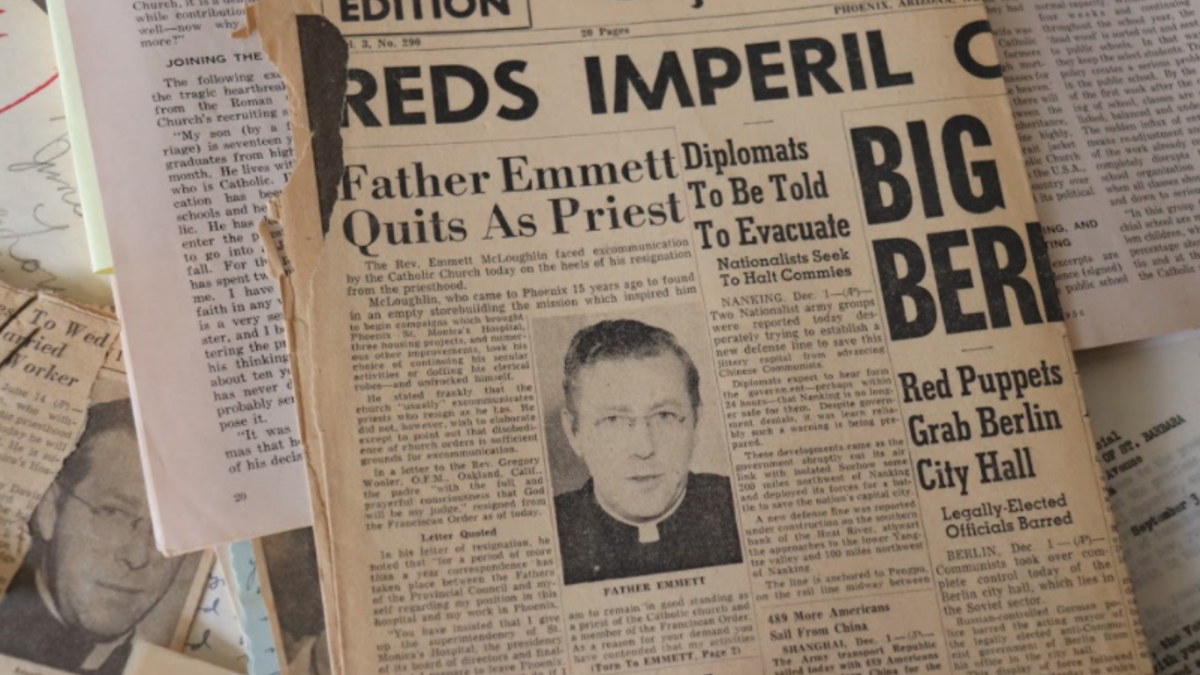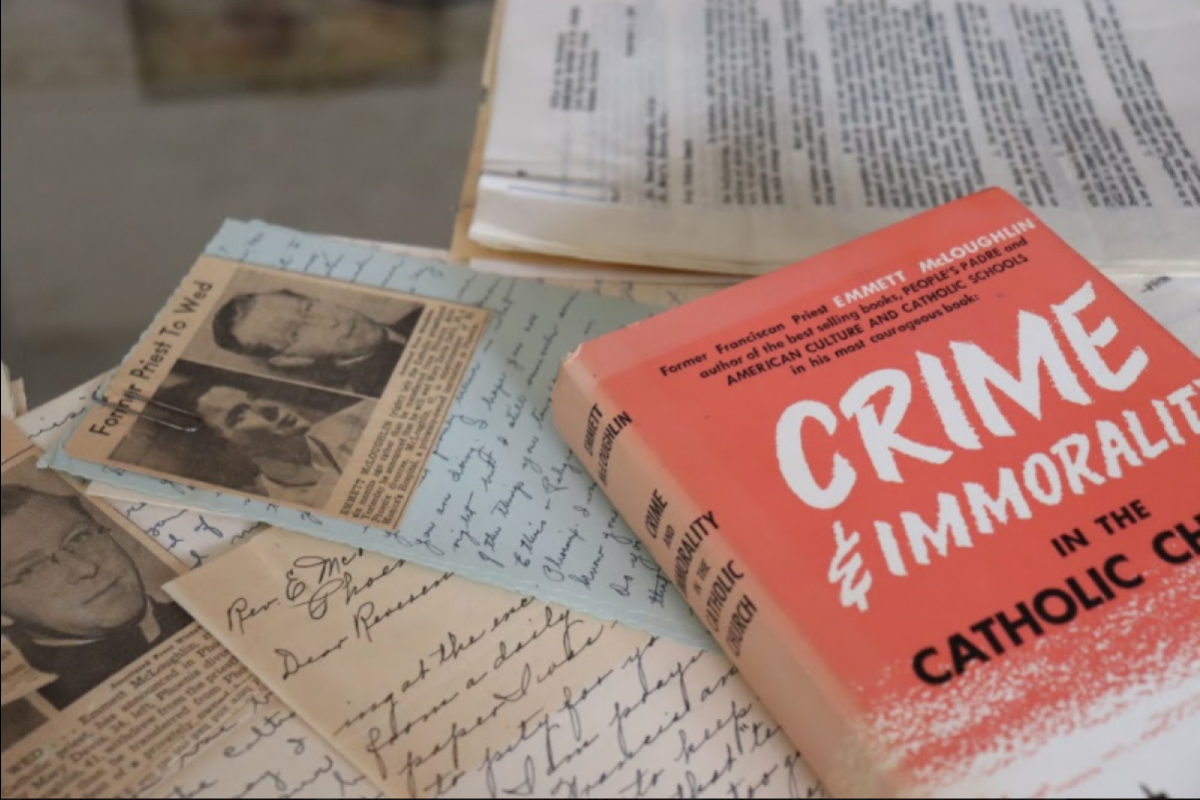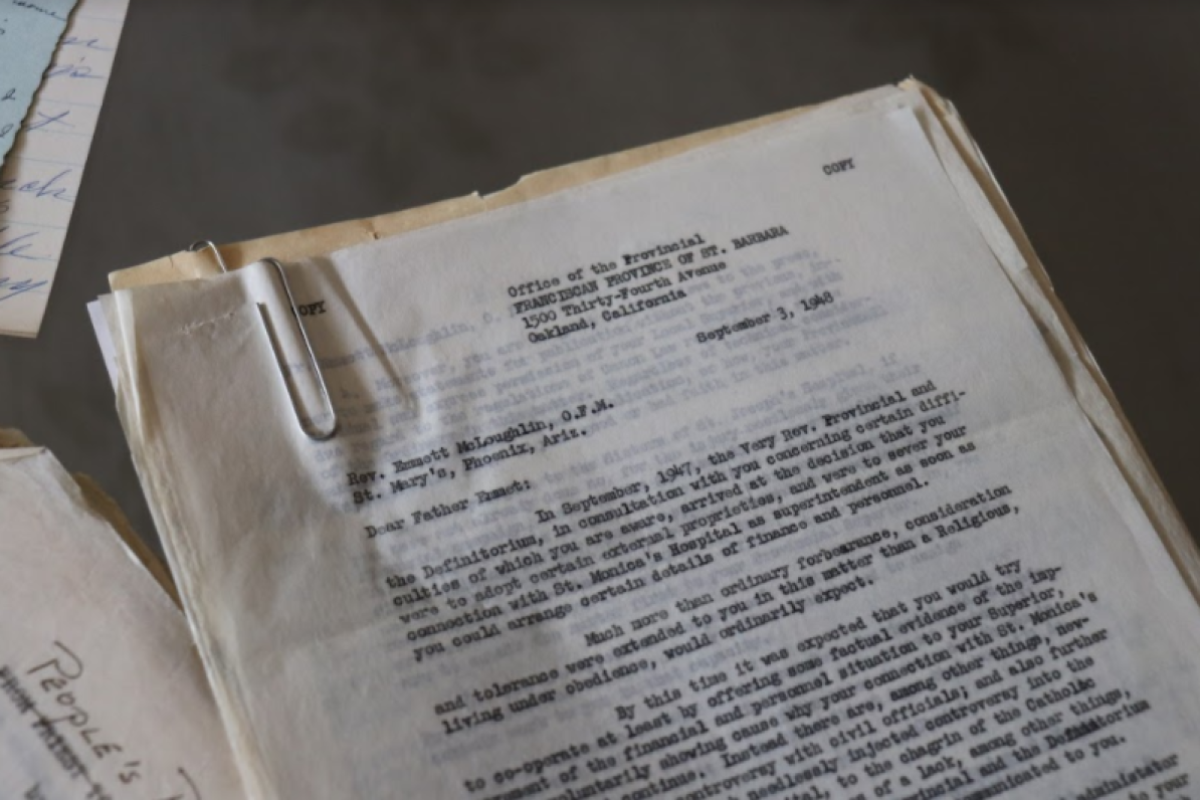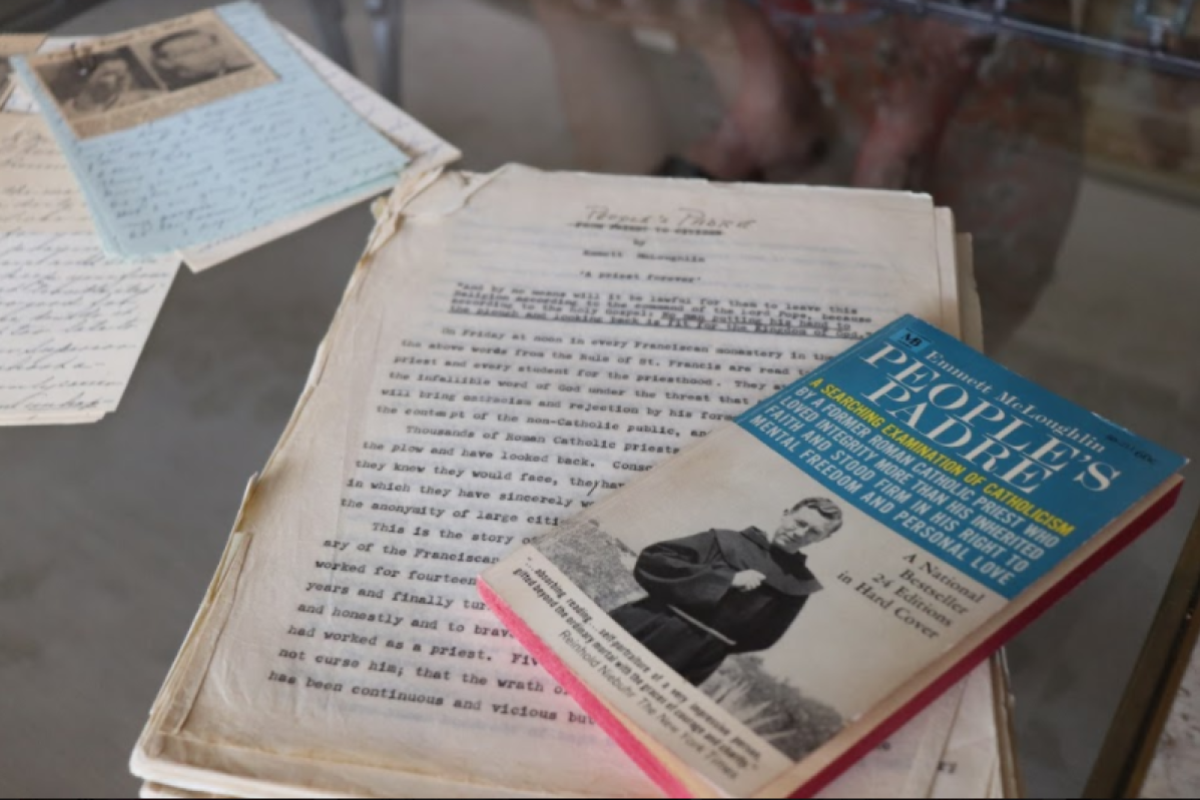A people’s man, a man’s legacy

An old Arizona Republic newspaper announcing Emmett McLoughlin's resignation from the Catholic priesthood. Photo courtesy of Rachel Bunning.
The Arizona State University Library is about to receive new documents for archival and housing in their facilities. Upon first glance, the filing box that has stored these documents may not look like much, but inside are yellowed carbon papers, laminated news clippings, scanned documents, first-edition books and handwritten letters all chronicling the history of a Phoenix landmark and the man who helped build it.
These documents follow the life and legacy of Emmett McLoughlin, the founder of Saint Monica’s Hospital in Phoenix, which later became the Phoenix Memorial Hospital on Buckeye Road and Seventh Avenue. The hospital housed the first racially integrated nursing school west of the Mississippi River in the United States and ultimately became the first medical care facility for poor communities in Arizona.
The hidden history contained in these papers were almost thrown out, but were saved by McLoughlin’s close colleague and friend Mary Neal Bennett. Bennett knew the documents were important and worked to make sure they were preserved and taken care of. She entrusted them to her good friend Barbara Lambesis, who is donating them to ASU. Lambesis and Bennett crossed paths when they both worked at the hospital and became good friends.
“(Bennett) was like my second mom, so we stayed very close until she died this last April,” said Lambesis. “She was 92 years old when she passed, so Mary trusted me one day about 11 years ago, she called me up and said, ‘Would you come over, I want to ask you to do something.’”
Bennett knew the significance of McLoughlin's work and waited to do anything with the documents until she knew his legacy would be documented properly.
McLoughlin’s journey to building the hospital and nursing school was not an easy feat and stirred up some controversy along the way. It all began when he was ordained to the priesthood by the Roman Catholic Church in 1933. He took vows to uphold the church and his faith and changed his name from John Patrick to Emmett in the memory of an Irish saint to symbolize the beginning of his new spiritual life as a Franciscan priest.
A provincial council of the Franciscan Order sent McLoughlin to Saint Mary’s Basilica in Phoenix in 1934 where he was tasked with doing outreach in the community. The community he was sent to serve in Phoenix at the time was primarily poor Black, Hispanic and white people who were struggling to get by.
“And what he saw was this abject poverty,” said Lambesis. “That (people) were living in shacks, if they had a place to live. They were sleeping under the bridges. They had absolutely no health care at all. Women were giving birth to their babies under bridges and in shacks and the mortality rate was horrible.”
McLoughlin decided that to be the best priest he could be, he needed to tend to the people’s physical needs rather than just asking them to come to mass every Sunday. To help, he entered a subscription contest for a local Catholic magazine and won enough money to purchase an old grocery store in the area. The store was renovated into a church and social hall for the members of the community.
“You can’t heal, you can’t have people turn to their spiritual needs until they have enough to eat, they have a place to stay, they have reasonable health care,” said Lambesis. “So that started him on a mission — so his little community center was called Emmett’s Mission.”
Although he was pleased with the center and the activities it provided to the community, he realized there was no clinic available to tend to people’s severe medical needs, especially the health concerns resulting from the lack of maternity care.
The building adjoined to the community center became the first maternity clinic in Arizona and offered a clean space for women to give birth, at-home birth assistance for free, access to birth control and treatment and testing for venereal diseases.
“It's definitely true that neither Phoenix nor Arizona had a well-developed health care system at the time, and Phoenix itself had fewer than 50,000 people in 1930,” said history professor Catherine O’Donnell, a facilitator of the document donation to ASU. “Because of poverty and discriminatory laws and practices, African Americans, Mexicans and Mexican Americans faced particularly great challenges when seeking health care.”
The church began reaching out to McLoughlin to let him know they were not happy with the medical practices happening within the clinic as it went against the beliefs of the church. At the time, the church did not believe in the use of birth control and believed that people with venereal diseases did not deserve to be treated because their disease was a reflection of their sins. But McLoughlin continued to provide the care despite the church's growing anger.
“It was equipped to be able to help them have their children and survive that ordeal and out of that ordeal came his desire to have a regular little clinic,” said Lambesis. “This community needed to have access to health care.”
He continued the clinic and became well-known as a champion of the community. On top of the clinic and community center, McLoughlin opened up the first playground in the area but wanted to help the community find stable and affordable housing as well. In 1939, he was appointed as the Chaplain of the Arizona House of Representatives and helped pass a bill to use federal funds for a Phoenix city housing project. Once the bill passed, he was appointed as the project's chairman.
By the time 1940 came around, neither McLoughlin nor the church were happy with his priesthood. He thought they were inconsistent, and they thought he wasn’t representing the church and his faith well. The church still supported segregation and McLoughlin didn’t agree.
“Although there were exceptions, the Catholic Church in the United States tended to follow the laws and social conventions that made the United States a segregated society,” said O’Donnell. “Some Catholic sisters and priests, among them McLoughlin, believed that their religion called them to challenge segregation, but the institutional church was slow in responding.”
In 1944 he raised enough money to open Saint Monica’s Hospital and nursing school and became the superintendent. The nursing school was the first interracial nursing school in the American West and the hospital was founded on the principles that everyone would be provided for no matter if they had money or not.
“He had Japanese American, Native American, Black, Hispanic and white women,” said Lambesis. “The women of color and the ethnic groups could relate to the patients even better sometimes because there was this trust they had. They all got along together and everyone was tolerant of each other. It was an amazing sort of place.”
McLoughlin and the Provincial Council of the church wrote to each other about their disagreements and his future in the church.
“They said he was not presenting himself as a man of faith, a man of Catholic faith, so they started to get on his case,” said Lambesis. “You will see there are letters going back and forth that they then decide he had a choice. He either had to give up being superintendent of the hospital and back off from that. He could still be involved, he could still be on the board of trustees but he could not be the person in charge and go back to running a civil church or they would ship him to Ajo.”
After years of back and forth, in 1948, McLoughlin decided to leave the priesthood and even went on to marry a woman, which caused a national uproar, especially among Catholics.
“He resigned (from the church), and that at the time was huge,” said Lambesis. “Then he married the medical records secretary of the hospital, who was divorced from the chief of staff, and that made national headlines.”
For a priest to leave the priesthood and go against his oath of celibacy by marrying a woman was big enough news. But add in the fact that she was a divorced woman, which at the time was against the Catholic church’s beliefs and practices, and you get some angry people.
McLoughlin received letters from all over the nation. Some told him he was going to go to hell for what he had done, others begged him to reconsider his choices and others were written to congratulate him on his marriage.
Despite the backlash, he continued working with the community and as superintendent of the hospital, hosting many charity events and fundraising to make sure its doors stayed open. In 1949, McLoughlin renamed the hospital to the Phoenix Memorial Hospital to honor those lost in World War II and that name remained until the hospital closed in 2002.
The legacy of the hospital and school was largely collected and preserved by Bennett. McLoughlin met Bennett in 1948 when she began working as a volunteer in the hospital. She was amazed by his mission to help everyone, and she worked at the hospital until her retirement in 1990.
She worked with him to keep the hospital open for the community and became one of his most trusted colleagues until his death in 1970.
“She was devoted to that hospital as much as Emmett was,” said Lambesis. “They were very close friends. When he died, the board of trustees made her the interim administrator of the hospital until they could hire someone else because she knew them so well.”
After McLoughlin passed, Bennett found and stored files about the history of the hospital, the nursing school and Emmett to keep them from being thrown out.
“It wasn’t about Emmett, but mostly it was about capturing the history of this place,” said Lambesis. “How it got started, how it served people, why it was needed.”
In 1989, Bennett presented the materials she had about the Phoenix Memorial Hospital, which included the gift of an original iron lung used at the hospital to treat polio patients, to ASU, where they were accepted into the university archives.
Then, in 2012, on behalf of Bennett, Lambesis donated the artifacts and materials regarding the nursing school to the Arizona Nurses Association for their historical archives. The only documents Bennett had left revolving around the hospital were those pertaining to McLoughlin. She knew the documents held historical value, but she didn’t want to donate them anywhere for fear they wouldn’t be handled correctly.
“She really wanted to be careful about Emmett’s papers because he was somewhat controversial in the end, particularly from the religious point of view,” said Lambesis. “She wanted to make sure that his memory would have been honored or his thinking would have been honored. His doing would have been honored and they wouldn’t somehow disappear in these papers. They wouldn’t be abused or they wouldn’t get into the hands of someone who didn’t care.”
The documents, which are being referred to as “McLoughlin's Papers,” are set to be housed in the ASU Library archives later this year.
“Phoenix has always been a place of many cultures and faiths, and there is a great deal of both conflict and collaboration in its history,” said O’Donnell. “McLoughlin's papers, along with other holdings of ASU Library, help us to see both, as well as giving us a sense of a man who made difficult and unexpected choices throughout his life, in pursuit of what he understood to be the good of others.”
More Health and medicine

The science of sibling dynamics: Why we fight, how we relate and why it matters
We have Mother’s Day, Father’s Day and even Grandparents’ Day. But siblings? Usually they get a hand-me-down sweatshirt and, with…

New study seeks to combat national kidney shortage, improve availability for organ transplants
Chronic kidney disease affects one in seven adults in the United States. For two in 1,000 Americans, this disease will…

New initiative aims to make nursing degrees more accessible
Isabella Koklys is graduating in December, so she won’t be one of the students using the Edson College of Nursing and Health…




